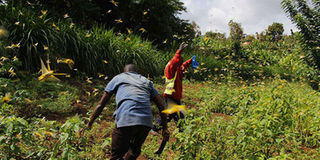Locust invasion munches into our precarious food security

Farmers try to scare away desert locusts at Mitunguu in Meru County on February 14, 2020. PHOTO | DAVID MUCHUI | NATION MEDIA GROUP
What you need to know:
- The multipronged locust invasion is growing at the speed lightning. It is not only out of control but is uncontrollable.
- We get back to the question of whether we need to review upwards our import projections for maize, wheat and so on.
Even before the current locust onslaught, Kenya’s strategic food position was precarious, particularly with respect to three of our main staples: wheat, maize and rice.
Further to that, we need to import over a quarter of our sugar needs and there is a lot of inward cross border traffic of onions and other vegetables and fruits.
Kenya imports majority of our wheat needs and a significant quantity of our rice requirements.
With maize, we have a structural deficit and only in a very good year do we not need to import any maize at all.
The structural maize deficit is cushioned by cross-border, often informal, imports from both Uganda and Tanzania.
Indeed, if one looks at the past year, these have actually helped us delay transatlantic imports of maize from countries such as Mexico.
At one stage last year, it looked as if we would need to import maize from South America to ensure we had enough to get us through to the next major harvest in November and December.
BAD POLICY
But reasonable short rain crops and cross border imports just managed to fill the gap.
The operative word is ‘just’ as the supply and demand equation has remained so tight that there has been an upward pressure on prices and Kenyans are paying high prices for food.
One can argue we listened to the powerful North Rift farmers more than our millions of consumers.
Bearing in mind that the government is committed to affordable food for its population, this hypocritical policy raises disturbing ethical and social questions.
Before getting into the locust factor, it is useful to flesh out the food scenario for the next six to nine months in Kenya as it appeared before the locusts flew into the equation.
The short rains crop was expected to be above average, which meant the need for imports would not be before March even possibly April this year.
One proffered scenario was to have an import duty free window for yellow maize for animal feeds from March to September and for white maize from April to September.
HARMFUL PESTICIDES
The figures were based on the projected shortfalls during that period until the next local crop was harvested.
The provision for yellow maize makes sense because it is significantly cheaper than white and would have a downward cost push effect on meat production costs.
But now with the exception of vegetables grown under the ground, all figures and projections are literally up in the air. What is being experienced now is one of the biggest conundrums ever.
The multipronged locust invasion is growing at the speed lightning. It is not only out of control but is uncontrollable.
The reactive patchy spraying with dubious, often dangerous, chemicals have arguably done more harm than good to the land and crops subjected to it. There are even reports of their harmful effects on humans.
Not only that but there is the question as to whether spraying is even an effective method of controlling locusts anyway.
PRICE RISE
The only known factor is the negative impact could be devastatingly high not only in crop loss from the voracious locusts but also in environmental costs.
Anyone in government who says the situation is under control is lying.
It is too early to give estimates or projections of losses at this juncture but a figure of 10 per cent overall crop loss is one guesstimate.
I fear that maybe that figure is on the low side, but I very much hope I am wrong.
I would follow that up by saying whatever the figure, it will continue rising. Further to that is the issue that any shortfall has a price knock-on effect.
If our ever faithful sukuma wiki becomes popular with locusts, then not only will its prices go up, but will in turn result in other leafy vegetables going up.
Last but not least, we get back to the question of whether we need to review upwards our import projections for maize, wheat and so on.





